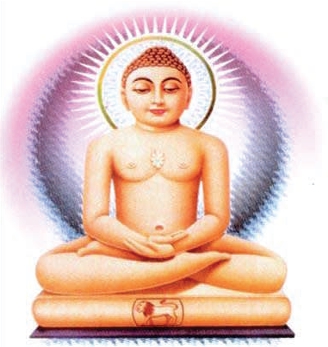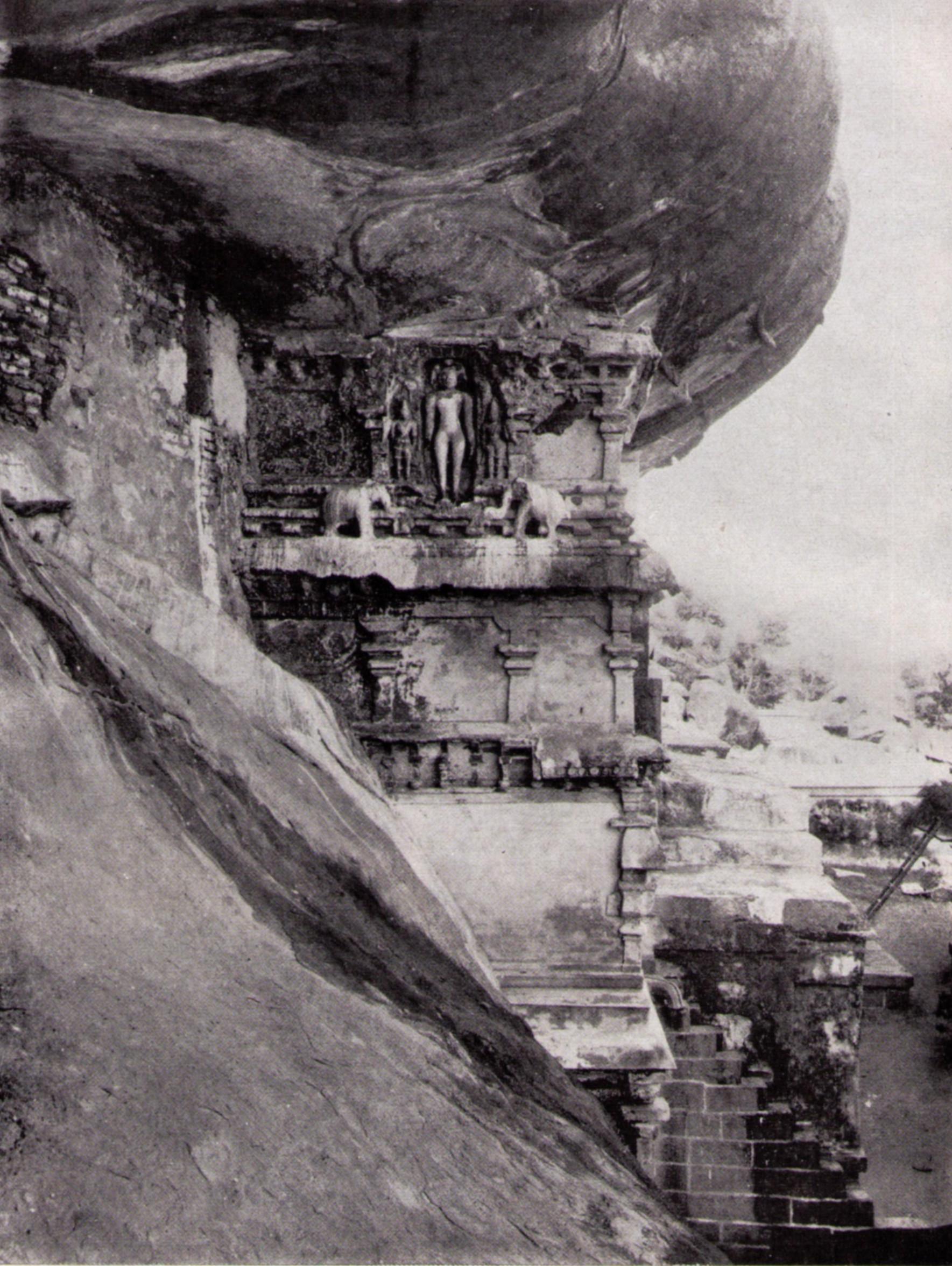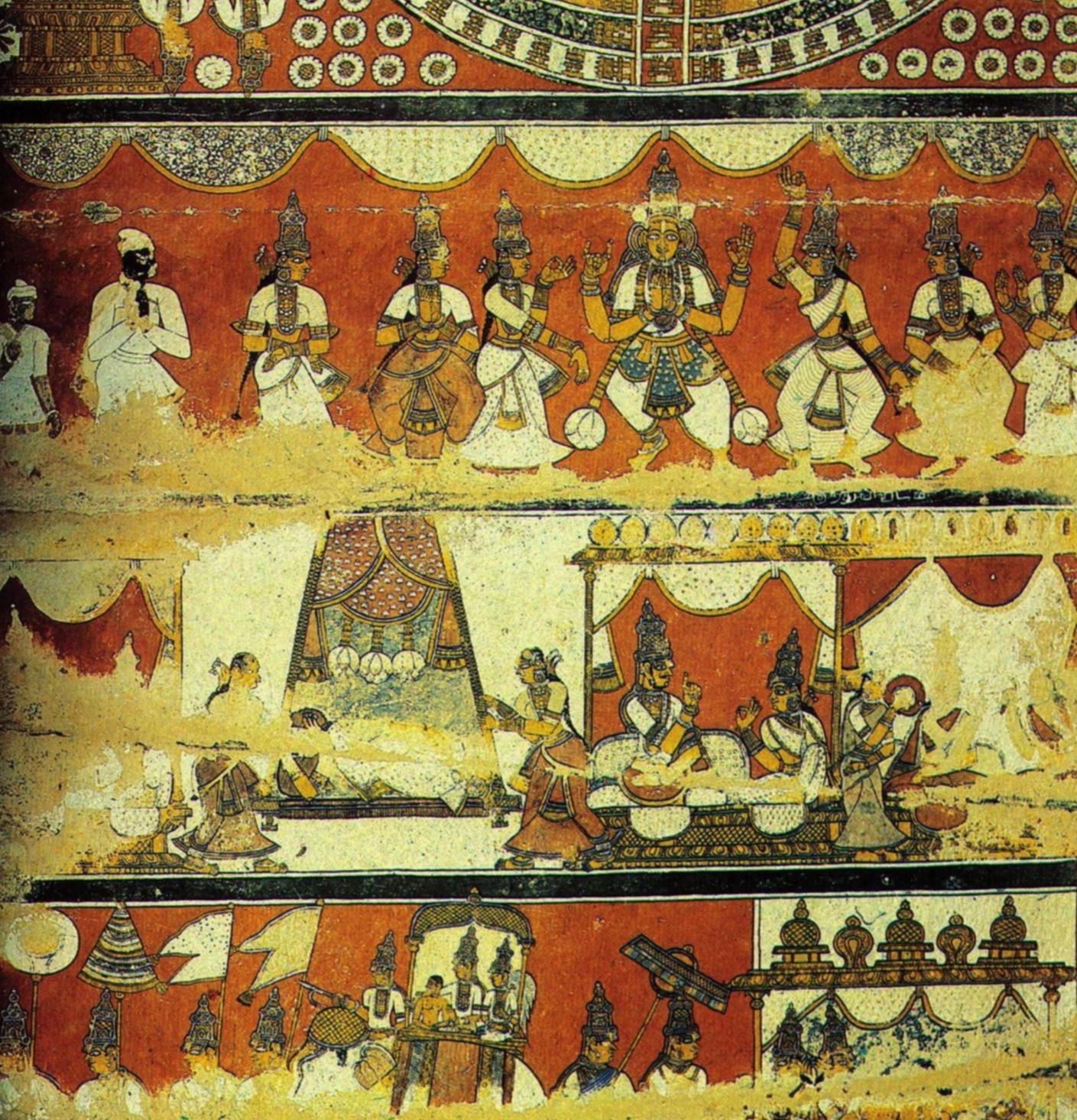
History of Jainism in Tamil Nadu (II)
During the time of Raja-raja III (A.D. 1226), Kūḍal Āḷappirantān Ēḷiśai Mōhan Kāḍava-rāyan made a grant to the Pārśvanātha-svāmi of Tiru-narungodai. During the same year, another grant was made to Narpa-t-ten-ayira-p-perum-palli (nārpa-t-teṇṇ-āyira-p-pe-rum-paḷḷi) by Kolli-y-ūr Oḍeyān for burning a lamp before the yakshi image of Mēl-paḷḷi. An inscription belonging to the period of Kulottunga (A.D. 1193) in Āvaraṇi Nāga-paṭṭinam, Thanjavur (tañjāvūr), refers to the Citra-lēhai-p-perum-paḷḷi. In Kurur (kūrur), there was a Jaina temple, Kulōttuṅga-chōḷa-p-perum-paḷḷi, which is referred to in an inscription in a Shiva temple in Kuhur (kūhūr). Another record of the period of the same monarch, found in a Shiva temple in Maruttuva-k-kuḍi (Pāpanāśam), refers to some pallis.
The Kadava-rayas (kāḍava-rāya) were the vassals of the Chola monarchs. During the period of Kulottunga-chola-deva II (A.D. 1137), Kulottunga-chola Kadava-rayan made a grant for the offerings to the image of Kacci Nāyanār. During the period of Kulottunga III (A.D. 1187), Vīra-śēkhara Kāḍava-rāya made a grant of three villages to the god of Narpa-t-teṇṇ-ayira-p-perum-paḷḷi.
Among the Pallavas, there were Jainas and promoters of Jainism. A copper plate of the period of Pallava Simha-varma discovered from Pallan-kovil (paḷḷan-kōvil; Thanjavur), written in Sanskrit, grantha and Tamil characters, mentions that the king made a grant of the village, Śramaṇāśrama, to Vajra-nandi of Nandi saṅgha. This record, though recovered from Pallan-kovil, originally belonged to Kanchi (kāñcī). An 8th-century inscription belonging to the period of Nandi-varma II, records the donation of some gold to the palli in Poṇṇiviḷaintāṇa-paṭṭi by, probably, the wife of one of the Muttaraiyan chiefs of Pallavas. An inscription in Kanchi belonging to the 9th century A.D., states that the queen, Lōka-mahā-devī, was affected by the Brahmarā-kṣasa. The Ācārya of Mahilam-paḷḷi is mentioned, which may show that the Ajīvaka (?) preceptor could alleviate the affliction of the queen.
 |
Neminātha temple(Rāṣṭrakūṭa period), built against cliff base in three floors with rock-cut images at floor level; Tirumalai Jain Temples. |
The Pallavas, Cholas, and the Vijayanagara kings patronized the Tri-kūṭa basadi of Jina-Kanchi. Mādēvī, wife of Kaṭakati-y-araiyar, who seems to be an officer of Pallava Kampa-varma (9th cent. A.D.), renovated a Jaina temple. During the period of Pallava Nṛpatuṅga-varma (A.D. 947), one of his officers made gifts to the Mūla-sthānattu-dēvar. An inscription in Olakkūr, belonging to the 8th century A.D., says that a Pallava king caused to cut the image of Pridivi Viḍaṅgi-kuratti. A few inscriptions belonging to the period of Pallava Kō-p-peruñ-ciṅga (A.D. 1246-49), record some structures in Tiru-narungodai by some officers or feudatories of this king.
The Pandyas (pāṇḍya), up to the 8th century A.D., were tolerant of Jaina religion and some of them contributed to the promotion of it. The tradition about the famous work, Nālaḍiyār, shows that the Pandya king had much respect for the Jaina monks. The Erukkan-kudi (erukkaṅ-kuḍi) inscription says that the officer of Pandya Sadaiya-māran Śrī-vallabha (A.D. 833) constructed a Perum-paḷḷi and a maṇḍapa in Erukkan-kudi. in Sāttūr taluq.
During the period of Vikrama-pāṇḍya (A.D. 1283-96), donations were made to the temple of Tiru-narungodai, as is mentioned in two donative records found there. An inscription belonging to the period of Jaṭā-varman Sundara Pāṇḍiyan (13th century characters), records that the dispute about the boundaries of the lands of a Jaina temple at Tiru-v-atigai (which is no more extant) and some other temples, was settled. In Tirunelvēli district, in Naṅguneri taluq, some Pandya records mention the grants made to Jaina institutions by the subordinates of the Pandya monarchs.
Mentions of Rashtrakutas (rāṣṭrakūṭa) are found in some of the inscriptions especially in the Arcot area. Kannara-dēva or Krishna III (A.D. 953) is mentioned in an obliterated inscription in Tirumalai in North Arcot. Naṅgaiyār, maid servant of Gaṅga-mā-dēvī, queen of Kannara-deva Pridi-gangaraiyar (kannara-dēva pridi-gaṅgaraiyar), gifted a lamp to the yaksha of Tirumalai hill. Kannara-deva Pridi-gangaraiyar is Hasti-malla. Another inscription belonging to the period of Kannara-deva (A.D. 939-68) is found in Vīḍūr in Tindivanam, the purport of which is not known as it is obliterated.
 |
Wall painting of Vardhamāna temple - Scenes from the life of Vardhamāna: Abhisheka. Vijayanagara; Tiruparuttikunram Jain Temples. |
The Sambuva-rayas (sambuva-rāya) were the vassals of the Cholas. Viravira-jinalaya (vīravīra-jinālaya) in Pūḍi, in Āraṇi in North Arcot, was built by Viravira of the Sambuva-raya dynasty, according to an inscription in the 13-14th century characters. A Sambuva-raya chieftain (A.D. 1173) of the Sengēṇi family had gifted 4 mās of land to Malai-nātha temple in Chittamur (cittāmūr). Another Sambuva-raya chieftain, feudatory of of the Cholas (A.D. 1236), in an inscription in Tirumalai near the painted cave, records the gift of the village, Rāja-gambhīra-nallūr. During the time of Kulottunga Chola (A.D. 1192), Raja-raja Sambuva-raya constructed a shrine in Peru-mandūr, Tindivanam, and installed the image of yakshi, which is known as Maṅgaiyar Nāyaki-Varasundari. According to another inscription, the next year, the same chieftain granted some land for the shrine he had constructed, at the instance ofone Malliṣeṇa.
The Vijaya-nagara kings also favoured Jainism in Tamil Nadu. An inscription says that Krishna-deva-raya (kṛṣṇa-dēva-rāya), when he ascended the throne in A.D. 1510, took steps to see that the Jaina and Buddhist institutions were benefited by making the dēva-dāna lands sarva-manya (sarva-mānya). By this, Vīra-rājēndra-cōla-p-perum-paḷḷi, at Karandai, was also benefited. It is seen in an inscription that Maha-mandalesvara (mahā-maṇḍalēśvara) Rāma-dēva Mahā-rāya of Vijaya-nagara made a gift of land to the Jaina scholar. Ommaṇa Uḍaiyar, son of Kampana Uḍaiyar, and grandson of Vīra-kampana, is mentioned at the beginning of the inscription. The Nāyaka mentioned as the one who gave money for the above-said land, might be a servant of the Vijaya-nagara king.
During the time of Mallikarjuna of Vijaya-nagara (A.D. 1452), in the inscription in Tirumalai, the king is said to have watched an elephant hunt. During the reign of Krishnadevaraya of Vijaya-nagara (A.D. 1519), one Maha-mandalesvara, Viṣṇu-dēva Mahā-rāja, made a grant to the god, Pārśvanātha, of the Maliyanār temple in Chittamur. Vijaya-nagara Raṅgadēva Mahā-rāja's agent, Timmappa-nāyaka (A.D. 1582), gifted lands for the maintenance of the musicians of Simha-puri-nātha (Chittamur) temple. During the time of Venkaṭa-patidēva of Vijaya-nagara (A.D. 1586), his officer, Raghu-nātha Nāyikkaṇ Aiyaṇ, is seen to have made the mānya lands, enjoyed by the temple and the 12 devaratiyars (dēvaraṭiyār) of the temple, sarvamānya (exempted from water cess).
The next inscription also exempts lands enjoyed by the paṇḍita, pūjaka, devaratiyar and drummer, from water-tax. In A.D. 1532, an inscription of Acyuta-deva Maha-raja gave an order, remitting certain taxes for the worship of Nāyanār Vijaya Nāyakar in Jambai. This is supposed to be the image of Bāhu-bali in the temple which is in ruins now.
 |
Wall painting of the Vardhamāna temple, Nāyaka, 17th century; Tiruparuttikunram Jain Temples. |
An inscription of Sāḷuva Nara-simha (A.D. 1471) says that some Shiva and Jaina temples in Tiru-k-kōliyūr were destroyed by the Oḍḍa army which were restored by the Vijaya-nagara king. Jaina art and architecture is found scattered in the eastern and southern districts of Tamil Nadu. The regions of Kanchi, Chittamur, Kalugu-malai, Tiru-c-cāraṇam-kuṇru, Tiru-narungondai etc., preserve rich architectural specimens and icons of the Jainas. Chittamur has beautiful murals, which is a rare specimen of Jaina art.
During the period from the 9th century to the 13th or 15th century A.D., the inscriptions show that there were many Jaina institutions which were much organized in structure and had played a great role in the propagation of Jainism in Tamil Nadu. Tiru-k-kāṭṭām-paḷḷi is mentioned in many inscriptions found in different areas. Many teachers are found mentioned and many of them were females. Jainism in Tamil Nadu always took care to preserve its own individuality. The temples and deities were named in Tamil, unlike in other places. P.B. Desai is of the opinion that yakshi cult developed in Tamil Nadu.
Jainism had its vicissitudes in Tamil Nadu, when Shaivism got deep-roots in that country. During the 8th century A.D., the Pandya king came under the influence of the Shaiva saint, Tiru-jñāna Sambandhar, and started to persecute the Jainas. On one single day, it is said that three thousand monks were crucified in the Pandya capital, Madurai. After this, a fall in the number of inscriptions is found in the Madurai region, with a corresponding increase in remote regions like Kanyākumāri, which shows the migration of the Jainas to other regions, though within the Tamil country itself. In spite of these misfortunes, Jainism survived in Tamil Nadu.
Bibliography:- Assimkumar Chatterji, A Comprehensive History of Jainism, Firma KLM, Calcutta 1978.
- K.A. Nilakanta Sastri, The Cōḷas, University of Madras, Madras 1956.
- K.A. Nilakanta Sastri, History of South India (4th ed.), Oxford University Press, Madras 1968.
- R. Gopalan, History of the Pallavas of Kāñci, Madras 1928.
- Ramasvami Iyengar / Sheshagiri Rao, Studies in South Indian Jainism, Vizianagaram Maharaja's College Publication, Vizianagaram 1922.
- Theodor deBray et al., Sources of Indian Tradition, Motilal Banarsidass, Delhi, (2nd imp.) 1963.
- E. Rapson (ed.), The Cambridge History of India (Vol. I), Chand &Co., Delhi 1962.
- P.B. Desai, Jainism in South India and Some Jaina Epigraphs, Jainasamskriti Samrakshakasamgha, Sholapur 1957.
- R.C. Majumdar / A.S. Altekar, Vākāṭaka Gupta Age, Motilal Banarsidass, New Delhi 1967.
- South Indian Inscriptions (SH).
- Epigraphica Indica (EI).
- A. Ekambaranathan / C.K. Sivaprakasam, Jaina Inscriptions in Tamil Nadu, Research Foundation for Jainology, Madras 1987.
 P.M. Joseph
P.M. Joseph